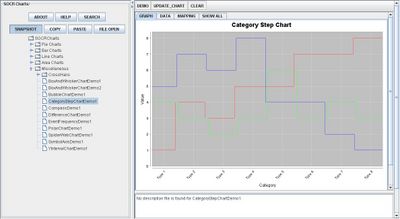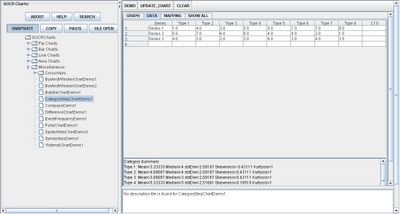SOCR EduMaterials Activities 2D CategoryStepChart
From Socr
(→CATEGORY STEP CHART) |
|||
| Line 1: | Line 1: | ||
== CATEGORY STEP CHART == | == CATEGORY STEP CHART == | ||
| + | |||
| + | ==Summary== | ||
| + | This activity describes the construction of the category step chart in SOCR. The applets can be accessed at [http://www.socr.ucla.edu/htmls/SOCR_Charts.html SOCR Charts] under the Miscellaneous folder. | ||
| + | |||
| + | ==Goals== | ||
| + | The aims of this activity are to: | ||
| + | * show the usefulness of category step chart | ||
| + | * create better understanding of the category step chart by users following descriptions, examples, and exercises | ||
| + | * connect the category step chart with daily activities | ||
==Background == | ==Background == | ||
Revision as of 17:33, 4 May 2008
Contents |
CATEGORY STEP CHART
Summary
This activity describes the construction of the category step chart in SOCR. The applets can be accessed at SOCR Charts under the Miscellaneous folder.
Goals
The aims of this activity are to:
- show the usefulness of category step chart
- create better understanding of the category step chart by users following descriptions, examples, and exercises
- connect the category step chart with daily activities
Background
The Category Step Chart is one way to display trends visually. It is often useful for averages over a time period.
For references, visit Step Charts for Excel and Step Charts.
Description
Go to the SOCR Charts and select Miscellaneous from the items located on the left, then select Category Step Chart Demo:

The image above is a basic demonstration of Category Step Chart. Note that there are three separate graphs on the chart, each with its own trend.
Data Type and Format
By clicking Data between the Graph and Mapping button, it allows users to input or vary the values of the data set. Numerical values are only required to create Category Step Charts. Users should input the data values in the corresponding categorical event as the image below demonstrates this:

Applications
One of the most persuasive elements when proposing data and literature to others is a well-designed chart presentation.
Researchers may utilize the Category Step Chart for specific trends of natural characteristics during a period of time. For example, the trends of humidity or temperature for every decade in a century.
Scientists may also use this application to easily display their results of trends in bacteria growth over a given period of time.
Translate this page:
